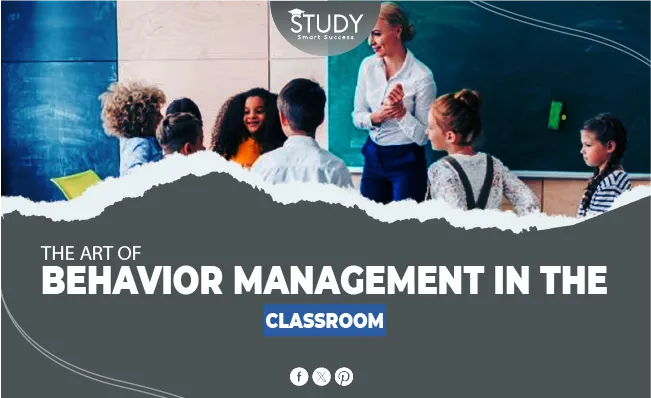When you walk into a classroom, it’s like walking into a miniature version of society. It’s full of possibilities and complicated people. Managing classroom behavior is both an art and a science, as any teacher who has spent time with a group of students can tell you. It’s not just about keeping things in order; it’s also about making a place where people can learn. This place aims to help teachers gain a more profound, more detailed knowledge of classroom behavior management strategies that encourage good behavior and create a fun and happy learning environment.
Do you want to learn how to handle disruptive behavior in the classroom? Visit our latest blog to upgrade your teaching skills.
The Basics of Classroom Behavior Management
Understanding the basics of a well-run classroom is essential before we can get better at the art. Every behavior management method is based on being consistent, being clear about what is expected, using positive feedback, and giving reliable and fair penalties.
Setting Clear Expectations
The best-laid plans for behavior management in the classroom can be destroyed by ambiguity, which breeds inconsistency. First, ensure the rules are clear and aligned with the ideals you want to teach. Whether it’s respect for others, being ready to learn, or duty, these things should not only be made clear, but students should also, if possible, agree on them as a group.
Positive Reinforcement
Behavior management makes the mistake of always focusing on the wrong things. Discipline is essential, but positive feedback is much more effective and should be the central part of your plan. An upbeat class culture can be built with simple praise, like “Well done” or a class award for good behavior.
Consistency Is Key
If you think of standards as a guide, then stability is like the North Star. Students should know that rules will always be followed, no matter how the teacher feels or the day of the week. This doesn’t mean discipline; it just means that there is a standard way to give praise and deal with bad behavior.
Addressing Misconduct
Quick and fair penalties must be shared when students do not meet the set standards. These penalties should be taught alongside the rules, and students should understand the escalation process if the wrongdoing continues.
Understanding the Root Causes of Misbehavior
Misbehavior is often a symptom of something more profound. By finding the reasons, we can react carefully and kindly, ensuring that the response is not just punishing but also helpful.
Emotional Triggers
Destructive behaviors can be a result of frustration, rage, and shame. The gap between a student’s capabilities and the difficulty of the task at hand might be detrimental to their self-assurance. Instructors can respond with empathy and a more personalized approach if they know these emotional triggers beforehand.
Environmental Factors
An atmosphere in the classroom might be a factor that contributes to inappropriate behavior. Each of these factors—social dynamics, bodily comfort, and sensory overload—can play a role in the situation. Students can act out to communicate that something is wrong in their immediate surroundings.
Individual Differences
All of the students come with their own experiences and requirements. What is successful for one person could not be successful for another. Understanding these individual characteristics enables one to use a behavior management strategy that is more personalized to the individual and more successful.
Incorporating Technology in Behavior Management Systems
Technology can be a tremendous ally in contemporary classroom management by providing solutions that expedite administrative work and providing new methods to involve students in the process of monitoring and improving their behavior. It gives teachers the ability to manage their classrooms better.
Digital Tracking & Analysis
Platforms that enable educators to capture and analyze data on student behavior might provide the opportunity for profound discoveries. There is a possibility that patterns may develop that indicate the need to modify the rules that govern the classroom or for a more individualized intervention for specific pupils.
Classroom Gamification
Recording students’ behaviors in a game might make it more attractive for the kids to participate. Developing a feeling of success and healthy competition is possible via leaderboards, badges, and awards such as virtual (or real) cash. This may serve as an incentive for beneficial behaviors.
Parental Involvement Apps
Keeping parents in the loop can be very helpful for a united front in behavior management. Apps that let parents know about their kids’ behavior in real time can help them have meaningful conversations and get help from home.
Creating a Positive Learning Environment
The environment that behavior management tries to keep is very important. It should be a place that encourages discipline and a love of learning.
Classroom Layout
The way a classroom is set up can affect how people act. Seating arrangements that can be moved around or areas set aside for group work and private study can be powerful visual cues that change based on the lesson and the students.
A Culture of Respect
Respect should go from teacher to student, student to teacher, and peer to peer. Being an excellent example of respectful behavior and encouraging open-mindedness can change how people interact in the classroom.
Engaging Lesson Plans
Misbehaviour has an opposite: engagement. The likelihood of students acting out can be significantly reduced by a lesson that interests and challenges them. Dealing with different learning styles and interests makes behavior management less critical.
Proactive Management Strategies
Most of the time, prevention is better than therapy. In school, being proactive can help stop bad behavior before it happens and make the space a better place to learn.
Building Relationships
Spend some time getting to know your kids. A good connection between a teacher and a student can help them accept and understand each other, which makes it easier to deal with behavior in a way that works for each person.
Expectation Previews
Before each task, go over what is expected of you. This lets students know what behavior you want from them, setting them up for success. It’s a small thing that can help keep problems from happening.
Differentiation
By using different teaching methods, you can meet the needs of more students and keep them from acting out when they are bored or angry. It shows students that you care about and understand what they are learning.
Progressive Discipline
A progressive approach to discipline is often better than a one-size-fits-all response when behavior problems can’t be stopped.
Verbal Warnings
First, gently remind them of what you expect that isn’t happening. This kindness gives students a chance to change their actions without things worsening.
Time-Outs and Reflection
A short time-out can help students get back on track when constant interruptions occur. It allows you to think about their actions and why they did them. This time should never be used as a punishment but for good things.
Collaborative Problem-Solving
A collaborative approach can be used when the real problem can’t be fixed easily with traditional discipline. Get the student involved in finding a way to do it that meets the class’s needs and works for them.
Reflecting on Your Approach
In any job, it’s important to reflect every so often. Managing behavior in the classroom is no different. Think about your methods, how well they work, and how they fit with your overall philosophy about education.
Keep a Reflection Journal
Writing down your daily successes and problems can give you helpful information over time. It’s a way to evaluate yourself that can be very telling.
Seek Feedback
A lot of teachers work with other teachers. Use this network to get feedback on how you’re managing behavior. Different points of view can help you find new ways to do things or improve the ones you already have.
Stay Informed
Finally, education is a field that is constantly changing, just like any other. Keep up with the newest research and best methods for managing behavior. Opportunities for professional growth can give you useful new tools and strategies.
Keeping students in line may be one of the hardest things about being a teacher, but it’s also one of the most rewarding things to learn. Teachers can make classrooms that are not only well-behaved but also lively places to learn by combining the basics of discipline with a deep understanding of the things that affect behavior and by using available tools and strategies. Teachers can slowly turn their “management art” into an “art of inspiration” by following through on their plans, praising students, and making it a point to keep improving.



